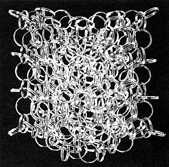|
Our last two newsletters explored Time and examined the claim of Carlo Rovelli that Time is a human concept that we find useful in science and in life, but which has no fundamental basis in nature. Carlo may be the most imaginative living physicist, so we should seriously consider his shocking claim that Time isn’t real.
After the last newsletter, some of you have asked: What about space? Since Einstein unified space and time, is Space real? Rovelli says No — Space is also only an emergent property, a useful human concept like beauty or justice that has no fundamental basis in nature.
Carlo Rovelli, Lee Smolin, Martin Bojowald, and many others are developing the theory of Loop Quantum Gravity. They base this theory on Einstein’s general relativity, quantum mechanics, and the assumption that space and time are quantized, as is nearly everything in the micro-world. This theory makes no additional physical assumptions, although both general relativity and quantum mechanics must be reformulated in quantized spacetime.
Loop Quantum Gravity employs these ideas to describe space, time, and gravity, and ultimately, the theorists hope, to describe the entire universe, from the infinitesimal to the immense.
They interpret Einstein’s fundamental equation of general relativity, G = 8π T, quite literally, claiming it says spacetime is nothing more than a manifestation of gravity. [In this equation, G determines the geometry of spacetime and T is the density of all sources of gravity. So no gravity, no spacetime.]
Their equations describe space in terms of continually morphing interlocking loops (illustrated below). These loops do not exist in space; they are space.

Any given arrangement of these loops represents one quantum state. What we call Space is a continually changing mixture — a quantum superposition — of innumerable such states. See below for more about quantum superposition.
In this vision of reality, at the most fundamental level, at the smallest scale, it is impossible to define a ruler or a clock — Space and Time are meaningless.
Loop Quantum Gravity has made great progress over the last few decades, but it still has a very long way to go to become a validated, comprehensive theory that could gain general acceptance.
Yet this theory has already made one intriguing prediction: our Big Bang was actually a Big Bounce. The loop-structure of quantized space limits how much energy and matter can be compressed. Perhaps when energy and matter collapse too much, they bounce back — like a falling basketball bouncing up from the floor.
Perhaps a prior universe (or ?) started collapsing into a smaller and smaller ball. When it reached the loop quantum limit, it bounced outward in all directions, creating our Big Bang. Carlo thinks astrophysicists may someday discover traces of that bounce.
One might well ask: if space and time are so chaotic and unrecognizable at the micro-world scale, why do we see them so differently at our macro-world scale?
To address that, let’s examine quantization, a key principle of quantum mechanics.
Quantization is fancy word for the simple idea that many things come in discrete rather than continuous amounts, as illustrated below.

A ramp (right image) is continuous; the red box can be at any elevation we choose. In the macro-world, where we live, ramps are everywhere — planets can orbit stars at any distance. But in the micro-world (left image), quantization rules; staircases with only a few large steps are everywhere — electrons can orbit nuclei only with specific energies.
As we “zoom up”, from the micro-world to ever larger sizes (moving from left to right), the steps get ever smaller and more numerous. Eventually, at our scale, in the macro-world, the steps are so small and so numerous that we perceive only ramps. Quantization exists at all scales, but only our most exquisite instruments can detect it in the macro-world.
Only as we zoom up to the macro-world, only as the staircase steps become imperceptible, do Space and Time emerge as useful idealizations.
Above, I mentioned quantum superposition — what is it? A superposition can describe a particle that exists simultaneously in multiple, often incompatible, conditions. Each distinct condition is called a quantum state.
For example, an electron can “be” in myriad different places at the same time, and can spin clockwise and counterclockwise simultaneously. A superposition defines how likely a particle is to be in each possible state at any given time. These likelihoods can vary greatly from state to state, or from one moment in time to another. A superposition can also describe waves, energy, or in the case of Loop Quantum Gravity, space and time.
For more comprehensive and accessible explanations of key quantum principles, read my print book Feynman Simplified Part 3 or my ebooks Quantum Mechanics 1 – 5 .

Best Regards,
Robert
June, 2019
Note: Previous newsletters can be found on my website.
|